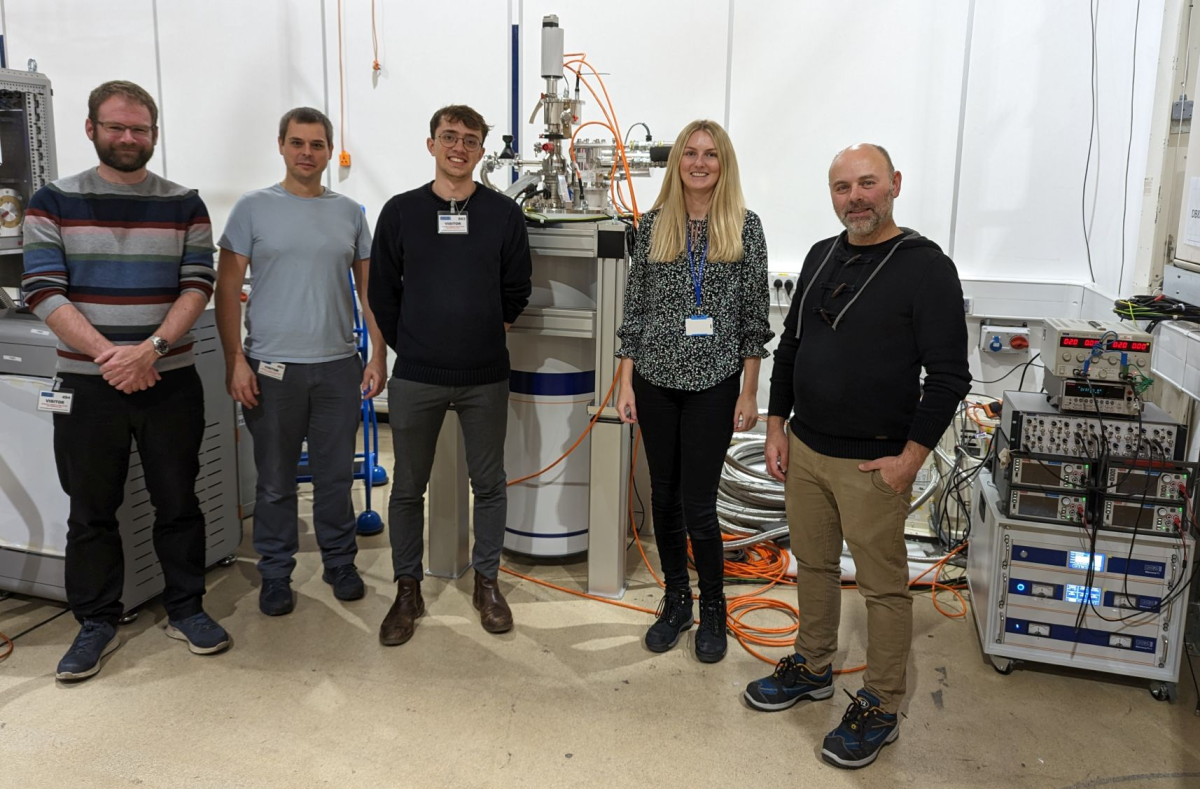Applications
 Part of the Oxford Instruments Group
Part of the Oxford Instruments Group
Expand
Collapse
Oxford Instruments Measurement Scientist Dr Abi Graham sat down with George Ridgard from the University of Lancaster to ask him more about the low temperature research he recently carried out at Oxford Instruments NanoScience’s Apps Lab, along with Dr Micheal Thompson and Professor Jonathon Prance from Lancaster.
Opened last year, the Tubney Apps Lab allows Oxford Instruments NanoScience to work with academic researchers and industry collaborators with the aim of developing our products and technology, as well as support more research in the field of low temperature and high field environments. In the lab, we have our TelsatronPT cryostat with a 12 T magnet. The TeslatronPT is a dry cryostat with a variable temperature insert that is capable of stabilising temperature between 1.5 – 300 K with a stability of 50 mK. In addition to the cryostat itself, we have a range of measurement electronics for performing electrical transport measurements, including the LakeShore M81 Synchronous Source Measure System and the LakeShore M91 FastHallTM Measurement Controller.
Tell us about your research methodology and your objectives. How did your research come about?
Our research came about due to the need to have functional, low power electronics at cryogenic temperatures, especially amplifiers.
The main objective was to find Metal-Oxide-Semiconductor Field Effect Transistors (MOSFETs) that worked at low temperatures (less than 4 K) but could also be used in low voltage and low power circuitry. Low power and low voltage are essential elements so as not to heat up the cryostat and ruin temperature stability or put pressure on the cooling apparatus and degrade sample measurement.
Cryogenic amplifiers help measurements by increasing the signal-to-noise ratio and reducing the output impedance of the sample, increasing the bandwidth of the measurement. The overall effect of this is that smaller signals can be measured over a larger frequency range, increasing the amount of measurable rich physics in a cryogenic environment.
The specific MOSFETs we tested were designed for ultra low power consumption circuits at room temperature. This will allow us to determine the key characteristics important for circuit design, such as threshold voltage, subthreshold slope and transconductance at low temperatures.
Our ultimate goal was to find some working MOSFETs at low temperature, then we could characterise them and eventually use them in circuitry as amplifiers.
Why did you choose to use the OI Apps Lab?
Primarily, we chose to use the Apps Lab for our measurements because it gave us access to the TeslatronPT. The static helium gas atmosphere in this system was essential for further thermalising the Field Effect Transistors (FETs), something we couldn’t do in vacuum in the dry fridges we have in Lancaster.
This is especially important for low temperature measurements of FETs as the self-heating of the channel can make the FET temperature much higher than that of the base plate. High currents can distort I-V characteristics and hinder temperature dependence measurements.
What instrumentation did you use in the Apps Lab?
We used the TeslatronPT for the cryostat and two Keithley2450 SMUs to make the transport measurements. The device was mounted by a 16 pin DIP header on ceramic Aluminium-Nitride PCB to aid thermalisation.

The Lancaster University team in the Apps Lab (from left to right Dr. Michael Thompson, Prof. Jonathan Prance, and George Ridgard) with Abi Graham and Ben Yager from Oxford Instruments NanoScience.
What did your results show? What are the possible impacts for future research?
All of the FETs demonstrated well-understood low temperature changes such as improved sub-threshold slope, increased saturation current, increased transconductance and the kink effect.
Our results showed that two out of three threshold voltages of the FETs rose, making them unsuitable for low voltage circuits at low temperatures. The third, an FET that had a negative threshold voltage at low temperature, had approximately an 0 V threshold at low temperature, making it very suitable for low voltage circuitry.
The possible impacts for the future are that lower power, more efficient circuitry can be built by properly considering the doping/room temperature threshold voltage of the FETs. This would be of interest for cryogenic complementary metal-oxide-semiconductor (CMOS) designers who are creating circuitry for applications such as quantum computing, where power consumption needs to be minimised in order to keep the qubits coherent.
How did you find working in the Apps Lab?
Working at the Apps Lab was extremely easy and efficient. Prior communication allowed us to mount samples before coming down to the Oxford Instruments NanoScience site and when we arrived, the testing was practically a push of the button due to the availability of a DIP mount for the cryostat.
What's next for your research?
We hope to see our research published in the IEEE Journal Of the Electron Device Society.
There is also potential for commissioning a CMOS run in order to create FETs with threshold voltages that are close to zero at low temperatures. The aim of this would be to use smaller nodes to mitigate effects like the kink effect that we found in our FETs, making them more suitable for a host of low temperature, low noise, low power applications.
Abi Graham is a Measurement Scientist at Oxford Instruments NanoScience
George Ridgard is a Physics PhD student at Lancaster University